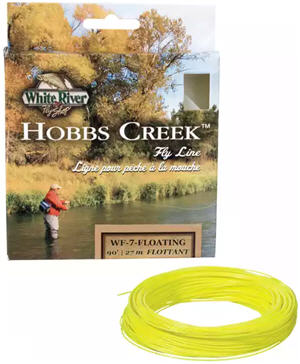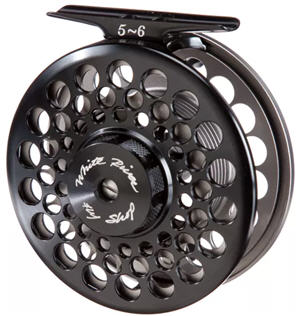
Fly reels are an integral part of every fly-fishing outfit. Much like a lead singer won’t perform well without a good guitarist, a fly rod’s potential can’t be realized without a fly reel that works in harmony with it. There are several things to consider when deciding which fly reel is right for you:

River Fly Shops Hobbs Creek Fly
Line
- Will it hold the fly line your rod needs?
- Does the drag have enough power to stop your target species? Will it help protect your tippet during fights?
- How much maintenance does it require?
- Does the size of the arbor match your needs?
- Is it made out of materials that will last, especially when fishing silt and saltwater?
Fly Reel Size
The size of reel you choose should mainly be decided by the amount of fly line and backing the reel can hold. Though a standard fly line is 90’ in length, diameter varies by line weight. Thus, an 8-weight fly line takes up more room than a 4 weight. Larger, farther-running fish need a lot more backing than farm-pond bluegill, requiring a larger spool.
Tip: Cabela's Prestige Plus WF Floating Fly Line is weighted 1/2 size heavier than AFTMA standards. Welded front loop makes attaching this line to your leader fast and easy. 2-toned weight-forward section; great for both freshwater and saltwater use.

Tip: Shop all fly reels at Cabela's here
Fly Reel Drag
There are two predominant drag systems in today’s fly reels. A click-and-pawl system is often found in traditional reels. It’s simply a toothed gear that is slowed by a spring-loaded clip. Disc-drag systems are found more often in today’s technologically advanced reels and have many variations. Two or more discs are pressed together, either by a spring or on their own accord (cork), creating friction and producing fish-stopping power.

space-age aesthetics with an industrial
strength carbon fiber drag system
Synthetics (Rulon, Delrin, Teflon) – These drag systems are heralded because they can last a lifetime. Also, they are self-lubricated, meaning there is no need to lubricate them yourself (in fact, you shouldn’t). It’s possible to seal them so they resist the harmful effects of silt and saltwater. They have slightly higher startup inertia than cork drags, but the difference is marginal.
Cork – These drag systems have very low startup inertia. Newton’s first law of motion teaches that objects at rest like to stay at rest, while objects that are moving like to stay moving. This means that the first moments of a fight have the greatest chance of breaking your tippets. However, because cork compresses, the force it takes to get the drag going is lessened, protecting tippets from hard-running fish. As the fish runs, the cork expands and pressure is quickly ramped up to fish-stopping levels.
It is important to manually lubricate cork drags, so sealed cork drags are not an option. If not maintained, cork will dry out and rot. Also, if it is constantly compressed – if you crank down the drag and just leave it – the cork will eventually lose its memory. Because cork drags do not use a spring to create pressure – spring is innate in cork – loss of memory results in a reel with no drag. Cork systems are rare to come by. Most discdrag systems are made of carbon fiber these days.

Large Arbor Fly Reel
Carbon Fiber, Graphite – Very similar to other synthetics, the added benefit of carbon fiber is that it dissipates heat quickly. The chances of it overheating and thus causing your reel to lose all drag are close to zero.
Large-Arbor, Mid-Arbor and Small-Arbor Fly Reels
Possibly the most significant advancement in fly-fishing technology since graphite fly rods is the introduction of large-arbor and mid-arbor fly reels. There are several benefits to having a larger arbor.
- Faster line retrieval – A large arbor retrieves more line with every crank. This is especially helpful for picking up slack line at the beginning of a fight and keeping consistent tension on the line, even if the fish swims at you.
- Less line coil – A larger arbor means that the fly line is wound on the spool in looser, more-open coils. These more-open coils create less line memory, causing the line to lay out straighter on the water. The larger coils also lead to longer line life, as the line endures less stress over time.
- More consistent drag – because the spool diameter remains almost the same as fish pull out more and more line, the force it takes to pull line out remains consistent. This means there is little need to adjust drag while fighting fish, making you less likely to break off fine tippets and more likely to control the fish.
While large-arbor reels have many useful advantages, small-arbor reels are also useful in certain situations. They are smaller, and smaller means lighter. This is important when you are using smaller rods. Using a large-arbor reel on a 7-ft. 2-weight rod can throw off the balance of your rod, making casting awkward. Small-arbor reels balance with smaller rods. Considering that the fish you will be catching with smaller rods and reels are probably themselves smaller, not having the benefits of a more consistent drag or faster line retrieval is negligible.
Several reels today have adopted a mid-arbor. These reels combine all the positive attributes from both small- and large-arbor reels; however, the benefits are not as pronounced.
Tip: Shop all fly reels at Cabela's here
Fly Reel Manufacturing Process
Machined – Machining produces the most durable reels available. If you are going to be fishing areas with a lot of boulders and rough terrain, machined reels are an excellent choice, as they can handle more abuse than either die-cast or stamped metal. Machined reels are also more corrosion-resistant than other reels because they can be anodized, thus making them good for saltwater, glacial silt and other harsh environments.
Die Cast – Manufacturing advances have made die-cast reels lighter and stronger in recent years. If you are looking for an economical fly reel that performs well, die cast is a good option. It can’t be anodized, however, so it is susceptible to corrosion.
Stamped Metal – Stamped-metal fly reels are both heavier and much less durable than either machined or die-cast fly reels. They are the most inexpensive reels on the market though, so if you’re trying save money, and you aren’t fishing for anything that can test a fly reel, stamped metal could be all you need.
- 12766 views

